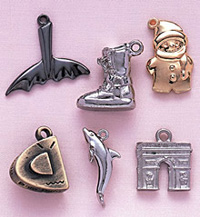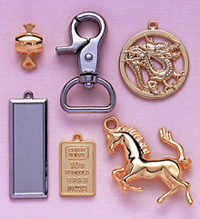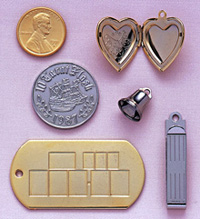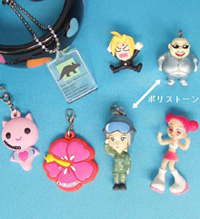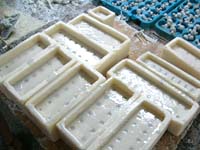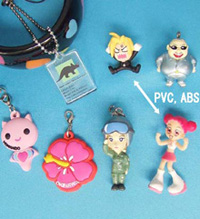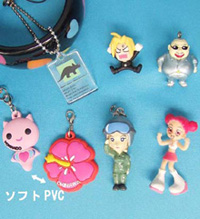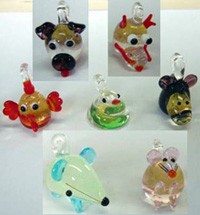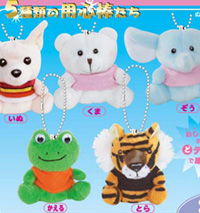Molding
We will realize the image you want as a product with various molding technologies.
Cast Rubber mold casting, also called rubber casting.
Material
Conventional: Alloy of lead and tin
Future: Lead-free tin alloys
Production target
For the production of three-dimensional objects that require realistic expressions.
For products that demand a feeling of weight and texture.
(Example: Character/relief, etc.)
Features
- It is highly profitable in small-lot production and the cost is relatively low.
- It used to contain a lot of lead, but now we are switching to a lead-free material for safety.
Precautions
Conventional rubber cast contains about 5% to 90% lead. Handle with care.
Die-cast
Material
Zinc alloy (zinc and tin)
Production target
For the production of three-dimensional objects that require realistic expressions.
For products that require finishing accuracy.
(Example: figures/miniatures/various parts, etc.)
Features
- Because it is a zinc alloy, it has higher strength and lighter weight than cast products (lead/tin alloy).
- The dimensional accuracy is high and the background is smooth and beautiful molding is possible.
- It has a high production capacity and excellent profitability during medium to mass production. Effective in controlling costs.
Press working
Material
Brass, aluminum, silver, etc. (material with high malleability is good)
Production target
It can be roughly divided into the following two types of molding.
(It depends on the mold and machine)
- Plate-shaped metal products (eg logo plates, coins, ID tags, etc.)
- Three-dimensionally molded product by bending or extruding thin sheet metal.
(Example: rocket, bell, etc.)
Features
- It is possible to make three-dimensional objects light, thin, short and small with high precision.
- Mass productivity is high.
- We can manufacture complex structures consisting of multiple parts, such as mechanisms that require opening and closing.
Sawing thing
Material
Mainly brass, aluminum, lacto
Production target
With a relatively simple shape, it can be used as a three-dimensional object with less unevenness on the surface and less change in flow surface.
Features
- Since no mold is used, it is possible to produce in small quantities.
- If the product design uses the material shape before construction, mass production is possible at low cost.
Precautions
Brass sawdust contains about 2% lead. Handle with care.
Lost wax
Material
Silver
Production target
Mainly for molding three-dimensional objects using silver (brass, gold, etc. are also possible) for products that require mass production.
Recommended for making higher-grade products.
(Example: silver ring, hanging pendant, etc.)
Features
- It is mainly effective for mass production of three-dimensional molded products using jewelry materials.
Made of resin molding (silicon type) poly stone (poly range)
Material
It is generally called polystone, which is a mixture of polyresin (synthetic resin) and stone powder to give it a heavy feel.
Production target
For the production of three-dimensional objects that require realistic expressions.
For products that demand a feeling of weight and texture.
(Example: Character/relief, etc.
Features
- Since it uses a silicon type, it is highly profitable in small-lot production. We support from a minimum of 1000 lots. (Please contact us for lots less than 1000)
- It is possible to enclose goldfish swimming in a fishbowl using transparent resin without mixing stones.
Precautions
Coloring is available only for full painting, hand painting, tampo printing, and water transfer. Since masking painting is not possible, some solid differences will occur due to the different colored lines and the thickness of handwritten lines.
Since it is cast in a soft silicone mold, the finished size of the product may vary by about XNUMX% even within the same lot.
Resin molding (3D mold) made of PVC, ABS, PLA
Material
In addition to conventional PVC and ABS, we also perform molding with PLA, which is said to be environmentally friendly.
Production target
For the production of three-dimensional objects that require realistic expressions.
Effective when you want to produce the same product in large quantities.
Features
- It excels in profitability in large-lot production, but its die cost is expensive.
- Since it is a mold, it can be painted uniformly by masking.
Precautions
Currently, PLA molding is in the testing stage, and it is only supported when there is enough time for delivery.
Resin mold (2D mold) Soft PVC or silicon
Material
Manufactured in silicon, including soft PVC (ATBC-PVC compatible).
Production target
The front surface is designed in a semi-solid form, and the back surface can be used as a screen wiper or a mirror built-in type
Features
- Since it is a semi-solid (2D) mold, the mold cost is low and the profitability in small-lot production is excellent.
- It used to contain a lot of lead, but now we are switching to a lead-free material for safety.
Precautions
There is a limit to the number of colors for silicon products due to workability issues.
Glass molding (handmade glass work) Gold powder and livestock powder can be enclosed
Material
Glass
Production target
It's all handmade, so it's not possible to express realistically as shown in the drawing, but while making the best use of the handmade texture, it is possible to process gold foil and phosphorescent light in the glass.
Features
- It excels in profitability in small-lot production (starting from 1000 pieces), and the cost is relatively low.
- Please note that the risk of breaking is unavoidable as it is made of glass.
Precautions
Please note that the glass contains some lead.
Sewing molding (plush toys) and talisman bags are also available
Material
From cheap polyester to nylon
Production target
Depending on the stuffing inside, it becomes a snow bead mascot, or it becomes a warmer that can be heated in a microwave oven.
Features
- Please contact us as the production lot depends on the stock status of the fabric.
- Please note that a license from the licensor is required for character objects.
Contact us.


